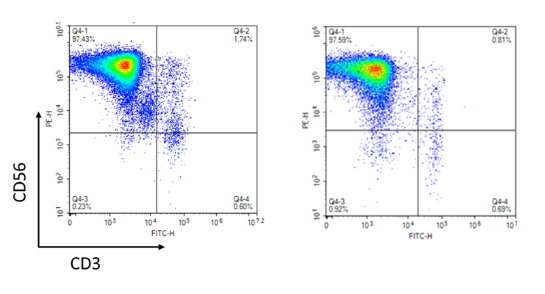Expanded Human Peripheral Blood NK Cells, Frozen
Expanded Human Peripheral Blood NK Cells are NK cells enriched and expanded from human PBMCs using the NK Expansion Kit (BPS Bioscience 78927), a K562 feeder cell-based system for about 2 weeks, and cryopreserved. Human Peripheral Blood NK Cells are >90 % pure NK cells (CD3-CD56+ cells), as measured by flow cytometry analysis. They can be used in NK cytotoxicity assays or ADCC (antibody-dependent cellular cytotoxicity), after thaw and recovery in NK Cell Basal Medium for 24 hours or can be further expanded using the BPS Bioscience NK Expansion Kit.
| Name | Ordering Information |
| NK Cell Basal Medium | BPS Bioscience #82164 |
| Growth-Arrested NK Feeder Cells | BPS Bioscience #78712 |
| Anti-NCAM1 Antibody, PE-Labeled | BPS Bioscience #101673 |
| Anti-CD3 Antibody, FITC-Labeled | BPS Bioscience #102008 |
| Human Interleukin-2 | BPS Bioscience #90184 |
| 500 x CFSE | BPS Bioscience #82177 |
| 1000 x 7-AAD | BPS Bioscience #82178 |
| K562 | ATCC #CCL-243 |
| eGFP/Firefly Luciferase K562 Cell Line | BPS Bioscience #78911 |
| eGFP/Firefly Luciferase RS4; 11 Cell Line | BPS Bioscience #78926 |
| Clear-bottom, white 96-well tissue culture-treated plate | Corning #3610 |
| U-bottomed 96-well plate | Corning #3799 |
| ONE-Step™ Luciferase Assay System | BPS Bioscience #60690 |
| Thaw Medium 2 | BPS Bioscience #60184 |
| Luminometer |
The cells have been screened to confirm the absence of Mycoplasma species.
NK (natural killer) cells are part of the innate immune system. They function in a histocompatibility complex-independent mode and derive from the hematopoietic lineage. They are the first line of defense against cancer. Expression of marker CD56 correlates with NK cell functionality: the CD56bright subset accounts for about 5% of the population and is less cytotoxic than the CD56dim subset. Cytotoxicity can happen by the release of perforin and granzyme, while activation by KARs (killer activating receptors) leads to release of Fas Ligand, TRAIL (TNF-related apoptosis-inducing ligand) and TNFα (tumor necrosis factor-alpha). In a suppressive tumor microenvironment, NK cells can become inhibited and unable to fight cancer cells. Several clinical trials have focused on using ex vivo generated NK cells alone or in combination with other approaches. NK cells can be generated ex vivo from peripheral blood, umbilical cord blood, iPS cells or immortalized NK cell lines. The ability to generate a number of pure cells high enough for human dosage often requires the use of growth factors such as IL-2 (interleukin 2) or IL-15, and feeder cells. The use of NK cells or CAR (chimeric antigen receptor)-NK cells is an expanding area holding great promise in cancer therapy.
Du N., et al., 2021 Cancers (Basel) 13 (16): 4129.



